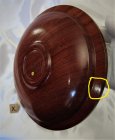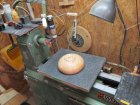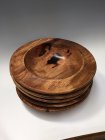odie
TOTW Team
- Joined
- Dec 22, 2006
- Messages
- 7,116
- Likes
- 9,818
I recently uploaded a photo of a Padauk bowl in the member's gallery......and, after I'd seen the blow-up photo, I was horrified to see some concentric lines in the flashpoint where there is direct reflection of light to the lens of the camera:

The odd thing, is these 600gt concentric sanding lines are not visible to me, UNTIL AFTER the Danish oil is applied and cured. Also, with finished bowls, these sanding lines aren't visible under normal room lighting, so I'm not too concerned about this particular bowl......but, I rely on my photos to sell my bowls online......Sooooo, this is entirely unacceptable.
These 600gt sanding lines are easily removed with 0000 steel wool after the Danish Oil is cured, but not so easily eliminated after the Beall 3-step buffing process.
I decided I needed a way to reproduce intense reflections, so that I can inspect for these concentric lines, and deal with them, AFTER the Danish Oil is applied, and PRIOR to the time I buff and wax. The solution, as it turned out, is to build an "inspection table" that mounted between the bedways of my lathe.

This is the perfect place for inspection and a little hand application of 0000 steel wool, because I have many sources of bright light at this location......incandescent, LED, and fluorescent.
Probably a few turners noticed the concentric lines, and I was wondering if anyone would point this out to me, but nobody did. Maybe that's a sense of consideration, or nobody really noticed this......?
Anyway.......one more problem solved. (I will not allow myself to accept flaws in my work.....they MUST be dealt with, and conquered! )
)
Have a good day gentlemen!
-----odie-----

The odd thing, is these 600gt concentric sanding lines are not visible to me, UNTIL AFTER the Danish oil is applied and cured. Also, with finished bowls, these sanding lines aren't visible under normal room lighting, so I'm not too concerned about this particular bowl......but, I rely on my photos to sell my bowls online......Sooooo, this is entirely unacceptable.
These 600gt sanding lines are easily removed with 0000 steel wool after the Danish Oil is cured, but not so easily eliminated after the Beall 3-step buffing process.
I decided I needed a way to reproduce intense reflections, so that I can inspect for these concentric lines, and deal with them, AFTER the Danish Oil is applied, and PRIOR to the time I buff and wax. The solution, as it turned out, is to build an "inspection table" that mounted between the bedways of my lathe.

This is the perfect place for inspection and a little hand application of 0000 steel wool, because I have many sources of bright light at this location......incandescent, LED, and fluorescent.
Probably a few turners noticed the concentric lines, and I was wondering if anyone would point this out to me, but nobody did. Maybe that's a sense of consideration, or nobody really noticed this......?
Anyway.......one more problem solved. (I will not allow myself to accept flaws in my work.....they MUST be dealt with, and conquered!
Have a good day gentlemen!
-----odie-----

